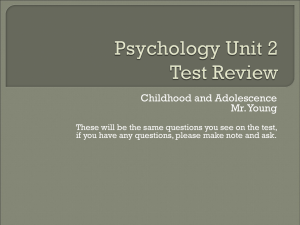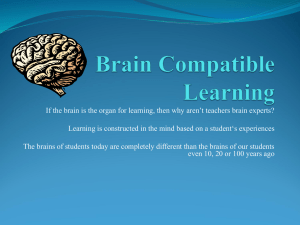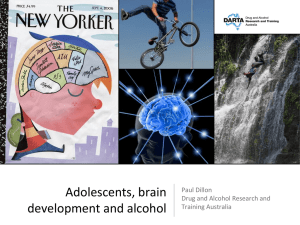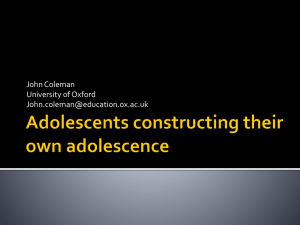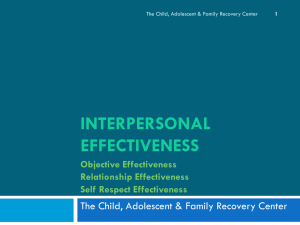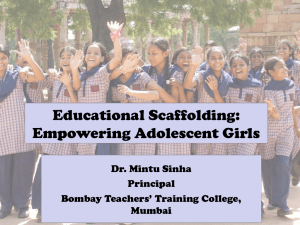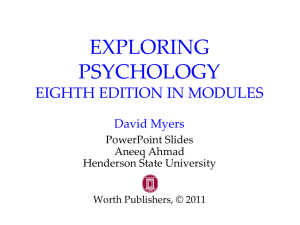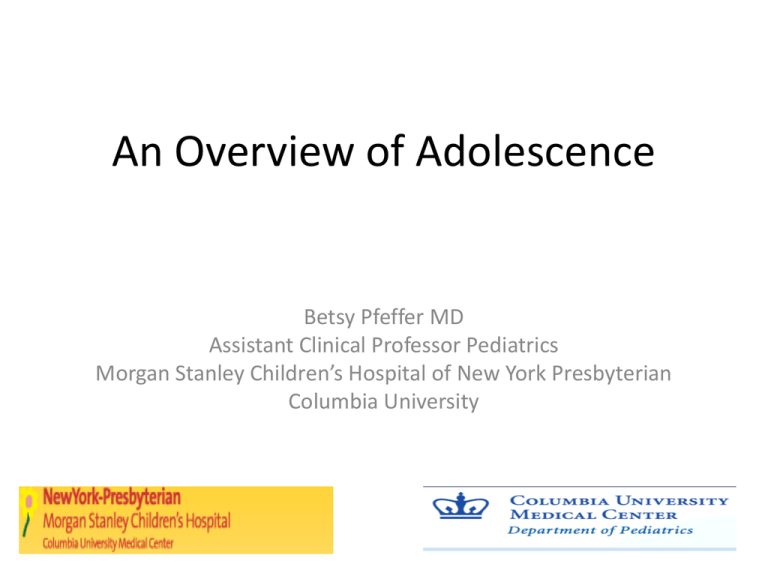
An Overview of Adolescence
Betsy Pfeffer MD
Assistant Clinical Professor Pediatrics
Morgan Stanley Children’s Hospital of New York Presbyterian
Columbia University
Overview of Adolescence
Through the Ages
What is Adolescence ?
“The state of growing up from childhood
to manhood or womanhood . . . The
period of life between puberty and
maturity . . . ”
Random House Dictionary
What is Adolescence ?
• In the classical world Aristotle (384-322 BC)
recorded what is known as adolescent
physical development but there were only
three stages of life: childhood, youth and old
age
• In the Renaissance, children stayed in school
longer but adolescence was still not defined as
a separate stage
What is Adolescence ?
Globally, traditional societies have observed
rites of passage signifying the emergence of
young people from childhood to adulthood,
no concept of adolescence intervened
between stages
.What is Adolescence ?
• Non-western societies had no defined stage of
adolescence, but the period between childhood
and adulthood often included unique
– Visual markers (clothing, hairstyle, body decoration)
– Pastimes like games/dancing,
– Carnivals and festivals created by adults to help
manage the sexual tension of this age group and to
help socialize youth into the conscience of the
community
• In non-western societies this period between
childhood and adulthood is typically 2-4 years
What is Adolescence ?
• In contemporary western societies, the period
of adolescence lasts between 10-15 years
– A youth culture developed in the mid 1900s
– The term teenager was coined in the 1940’s and
was the recognition that the adolescent group was
a distinct market segment with its own behavior,
tastes and opinions
.Perceptions of the Period between Childhood and
Adulthood Through the Ages = Trouble
• In the 4th century BC, Aristotle stated “Youth are
heated by nature as drunken men by wine”
• According to the English poet and playwright
William Shakespeare (1564-1616),
“I would be there no age between ten and three
and twenty, or that youth would sleep out the
rest: for there is nothing in the between but
getting wenches with child, wronging the
ancientry, stealing, fighting”
The Winters Tale
.Perceptions of the Period between Childhood
and Adulthood Through the Ages = Trouble
• In 1904, G. Stanley Hall, the American
Psychologist and father of adolescent research
defined adolescence as a stage of its own and
a time of storm and stress
• 1960s and 1970s: attempts to understand
adolescent problems as due to “raging
hormones”
.Today’s Perceptions of the Period between
Childhood and Adulthood =Opportunity
Although initially viewed
as a time of turmoil, large
scale studies have shown
that most teens progress
through this period of life
without obvious behavior
problems
Adolescence Today
• Increasingly young people are becoming recognized as
key participants in decision-making and development
of organizations
• Adolescents contribute to society in countless,
influential ways
–
–
–
–
They publish newspapers and magazines
Run businesses
Serve as leaders in schools and communities
Some manage households; some care for younger siblings
or ailing parents
• Bursting with vitality, curiosity and spirit, young people
have the potential to help advance the world
.The Health Paradox of Adolescence
• Childhood to
Adolescence
– Improved strength,
speed, reaction time,
mental reasoning
abilities
– Increased resistance to
cold, heat, hunger,
dehydration, immune
function
• However …..
The Health Paradox of Adolescence
• Overall morbidity and mortality rates
increase 200-300% from childhood to late
adolescence
• Injury and violence are the leading causes
of death
.Adolescent Behavior
• It is not their fault!
• Puberty and motivation and emotion linked to
“igniting passions” in the developing brain,
development of the limbic system Dahl 2003
• Skills of self regulation involving
neurobehavioral systems in the pre-frontal
cortex develop later
National Institute of Mental Health
• Cognitive development correlates with age
and experience, not puberty
Dahl 2003
The Modern Category of Adolescence
as a Product of Social and Cultural
Change
Pre-Industrial Society
In the pre-industrial world
– Young people are in a state of
semi-dependence and are
viewed as economic assets to
the family
– Youth learn early and by
example the function they are
to perform later in life
Transition to an Industrial Society
• With transitions to an
industrial-capitalist
economy social and
cultural changes emerge
• In the US and Europe this
began in the nineteenth
century and intensified in
the twentieth century
What are the Changes?
• Industrialization and
urbanization creates
– Movement to cities
– Exposure to cultural
diversity
– Dilution of traditional
values
• Progressive reforms bring
adolescents together
– Compulsory education
– Legislation against child
labor
Post Industrialization
• Cultural adaptation occurs allowing for
societal growth and development
– The middle class family strengthens
• A private realm with less ties to the community and
other adults
– Adolescents are concentrated in schools and
youth friendly centers
– Increased value is placed on individual choice and
initiative versus inherited status and prescribed
roles
– Identity formation
.Post Industrialization
• By the mid 1900s, in the United States and Europe, a
youth culture defined by distinct styles, behaviors
and interests emerges
• Peer groups become central to the youth culture
– Many parents both begin working out of the home so
teens are spending less time with parents and more time
with peers
– Peer groups become key in helping an individual develop
identity
• Prolonged dependence on parents leads to closer
and more emotionally charged interactions
.Adolescent Rebellion
• Leading theorists of adolescence note that
– With cultural growth and change, the past is no longer
an adequate guide for the future and children can’t
look to their parents for guidance about adult roles
– Rejection of parental values and allegiance with the
views of the peer group are vital components of
adolescents’ progress to adulthood
– The ability to move beyond the values and ideas of
one’s parents and to adapt to changing social and
political conditions is essential to the progress of
society
Western Youth Culture
Developed…….Then it Spread
• Migration via
– Mass media
– Rapid travel and mobility
– Other technological developments expand direct
communication and permits unlimited
opportunity for youth expression and connection
– “Rock music” shows up in remote villages
throughout the world
What Adolescent Culture Helps Resolve
• Who am I? Where am I going? Who am I to
become?
• As these questions get answered a
commitment to a system of values grows and
the capacity for intimacy and adult maturity is
achieved
• Formation of a healthy and stable self with a
strong identity
“Who am I?”
• This is a very difficult question
to answer!
• Healthy to challenge one’s self
and learn one’s own limit
• Your identity has many aspects
–
–
–
–
–
Values
Romance
Religion
Politics
Occupation
How do Teens Answer the Question,
“Who am I?”
• Some do follow in their parents’ footsteps
with little obvious signs of rebellion
How do Teens Answer the Question,
“Who am I?”
• Some teens develop a “negative identity.”
– Rebel against their parents in every way
– Always doing the opposite of what their parents
want
.But it is hard to be a teenager . . .
• It can be painful to ask questions such
as “Who Am I?”
• Physical changes
• Conflicts with parents, friends,
schoolmates
• Identity crises
• Peer pressure
The Journey from Childhood to
Adulthood Today
• Requires successful completion of adolescent
physical, psychological, social and cognitive
development
• Healthy to have answers to the question
“who am I?” by age 24 or 25
• Getting to this point may be very difficult and
requires
– Questioning parental/societal views
– Development of personal ideas, self worth, self
efficacy and social competence
Support of the Modern Adolescent :
Parents/Guardians Play a Key Role
• Parents /authority figures are major
participants in healthy adolescent
development
– Demonstrating acceptance of the
adolescent
– Understanding the teens are likely to accept
and promulgate parental values after going
through periods of rebellion and rejection
Parents/Guardians Play a Key Role
– Research has shown that most young
people share the deeper values of their
parents
– Role models/Setting examples
– Parental warmth has a universal association
with psychosocial well being
.The Modern Adolescent
• If a culture endorses the developmental goals of
autonomy, individuation and independence then,
it is helpful for all adults to
– Understand and accept what is normative adolescent
development and behavior (adolescent rebellion, risk
taking, healthy identification with peer groups, youth
culture)
– Interact non-judgmentally
– Support normal adolescent separation/individuation
– Act as respectful mentors/advisors to teens
Separation and Individuation
• May not be a primary development goal in all
cultures
• In some cultures, interdependency and
defining oneself as a member of a group is
more valued than individuality
• Often cultures embrace both individuality and
interdependence
Non-Western Cultures
• The result of the influence of western
culture is the homogenization of cultural
norms
• Societal structures based on respect for
authority are being threatened and strong
inter-generational bonds are being
weakened
Non-Western Cultures
Re-assess how the wisdom of
older generations and cultural
traditions can augment, and not
hinder, the growing needs of the
newer independent youth culture
The Birth of Adolescent Medicine
.A Doctor of Their Own
• Adolescent Medicine had its origins in England in
the 19th century physicians caring for boys in
boarding schools joined together organizing the
Medical Officers of Schools Association
• American medical interest in adolescents began
in college health in 1860 at Amherst College in
Massachusetts
• J.R. Gallagher MD, the father of adolescent
medicine in the United States, developed the first
adolescent clinic in 1951 at Boston Children’s
Hospital
A Doctor of Their Own
Dr. Gallagher recognized the benefits of a
confidential relationship with a physician
whom they consider to be their own
• Leads to the adolescent taking responsibility for
his/her own recovery
• Promotes sharing information
• For the adolescent who engages in high risk
behaviors, there is a greater change of accessing
heath care if confidentiality is assured
A Doctor of Their Own
• This clinic served as a model
for other adolescent
programs growing in the US
• The Society of Adolescent
Medicine was established in
1968
• In the 1970’s adolescent
medicine was incorporated
into pediatric education
Adolescent Medicine Today
• Adolescents face similar problems worldwide
– Accidents, homicide, suicide, depression, anxiety,
sexually transmitted infections, early sexual debut
and unwanted pregnancies, reckless behavior,
drug alcohol and cigarette use
• Value of individual autonomy
– Underlie the contemporary promotion of
adolescent health globally
– Lends itself to reinforcement of youth culture
Adolescent Medicine Today
We live in a global society and must keep
cultural differences in mind, cultural
sensitivity is vital to successful interaction with
the adolescent population
The Adolescent Climate Worldwide
Adolescents Worldwide
• The twentieth century began with 1.6 billion
people
• Currently there are 1.2 billion adolescents age 1019, more than 20% of the world’s population
• 50% of the world’s population is under the age of
25
• 85% of adolescents live in the developing world,
Sub-Saharan Africa is home to about 16%
WHO Facts
• Nearly 16 million girls aged 15 - 19 give
birth annually to 11% of all births
worldwide, mostly in developing countries
• At least 20% of young people will
experience some form of mental illness
WHO Facts
• Young people aged 15-24 accounted for an
estimated 45% of new HIV infections
worldwide in 2007
• The majority of tobacco users worldwide
begin during adolescence. Today more than
150 million adolescents use tobacco
• Harmful drinking among young people
reduces self-control and increases risky
behaviors
WHO Facts
• Unintentional injuries are a leading cause
of death and disability in adolescents
• Among 15-19 year olds, suicide is the
second leading cause of death , followed by
violence in the community and family
WHO Facts
“ One in every five people in the world is an
adolescent, and 85% of them live in
developing countries. Nearly two thirds of
premature deaths and one third of the total
disease burden in adults are associated with
conditions or behaviours that began in youth,
including tobacco use, a lack of physical
activity, unprotected sex or exposure to
violence.”
WHO
Status of Youth in Uganda
• In 2003, the Ugandan Global School-Based
Student Health Survey (GSHS) was conducted
among students age 13-15 yrs from 50 schools
to measure behaviors and protective factors
related to the leading causes of morbidity and
mortality in Ugandan youth
• The WHO, UNICEF, UNAIDS, UNESCO and the
CDC collaborated on this project
Status of Youth in the US
• The Youth Risk Behavior Surveillance System
(YRBSS) monitors health risk behaviors and
their prevalence in high school students in the
United States
• It is conducted every two years by CDC
• The most recent data is from 2007
Sexual Activity
• Uganda
– 21% of students had sexual
intercourse
– 59% used condoms during
last sexual intercourse
• US
– 48% of students had sexual
intercourse
– 35% within the past month
– 61% used a condom during
last sexual intercourse
Sexual Violence
• Uganda
– 21% of 15-19 year olds females
experience sexual violence
according to the 2006 Uganda
Demographic Health Survey
• US
– 20-25% of women in college
reported experiencing an
attempted or completed
rape in college
Fighting
• Uganda
– 36% of students were in a
physical fight and 64% of
students were seriously injured
one or more times 12 months
prior to the survey
• US
– 36% were in a physical fight
one or more times 12 months
prior to the survey
Drugs and Alcohol
• Uganda
– 9% used drugs one or more times
during their life
– 13% had alcohol in the past 30
days
– 15% reported being drunk at least
once
• US
– 38% used marijuana one or more
times during their life and 20%
were currently using
– 75% had at least one drink in their
lifetime and 45% were currently
drinking
Cigarettes
• Uganda
– 20% lifetime use
• US
– 50% lifetime use
– 20% current use
Mental Health
• Uganda
– 19% of students seriously
considered attempting suicide
– 10% of students felt lonely
most of the time or always
• US
– 14 % of students seriously
considered attempting suicide
– 29% of students felt
sad/hopeless daily for more
than 2 weeks
Adolescents are at Risk Worldwide
• What can adolescent providers
do to help
– Awareness of the challenges that
adolescents face
– Knowing the youth culture
– Talking to teens respectfully and
confidentially
– Encouraging parent/guardian
involvement
– Knowing the community
resources
– Providing anticipatory guidance
and heath education…….
Health Education…it Works
• School based programs that teach social
resistance skills and general life skills
successfully decrease the use of drugs, alcohol
and cigarettes
US dept of health and human services 2009
• Parental discussions about risk taking and risk
reduction is protective
Guttmacher 2009
• Discussions of contraception choices does not
increase sexual activity
Kirby 2005
• Access to emergency contraception does not
promote sexual risk taking
Harper, 2008
Health Education in Uganda
Youth Reproductive Health Policy 2005
• The role of young people in
Uganda’s successful efforts to
fight HIV/AIDS is well known
• Characterized by behavior
changes among youth, including
a delay of sexual debut, increase
in condom use, and reduction in
number of partners, HIV
prevalence has fallen by more
than half since the early 1990s
Health Education…it Works
• Comprehensive sex education programs that
provide information about both abstinence
and contraception
– Help delay the onset of sexual activity among
teens
– Reduce their number of sexual partners
– Increase contraceptive use when they become
sexually active
Kirby 2005
• Abstinence only programs are ineffective in
improving adolescent reproductive health
outcomes and actually increase the likelihood
of pregnancy
UNESCO 2008
Health Education…it Works
• Countries with conservative attitudes towards
sex education (including the US/UK) have a
higher incidence of STI’s and teenage
pregnancy
Advocates for Youth
• In US there are two main forms of sex
education
Guttmacher 2006
– Abstinence only and comprehensive programs,
both address abstinence as a positive choice
– There is currently no federal program dedicated to
supporting comprehensive sex education
Health Education…it Works
• The Netherlands has one of the lowest
teenage pregnancy and birth rates in the
world and higher rate of contraception use
UNESCO Courier
– Early institution of sex education encouraged
– Over half of the primary schools discuss sexuality
and contraception
– Aims to give teens the skills to make their own
decisions regarding health and sexuality
The Future
• Building our global community and working
together to keep our youth safe, helping them
grow into well integrated and productive
adults who actualize their potential
• “There is no passion to be found playing
small-in settling for a life that is less than the
one you are capable of living”
Nelson Mandela
Bibliography
•
•
•
•
•
•
•
•
•
•
•
•
•
•
•
Alderman, A. et al “ The History of Adolescent Medicine”. Pediatric Research 2003
Arnett, J. “Adolescent Storm and Stress” American Psychologist 1999
Arnett, J. “Stanley Hall’s Adolescence: Brilliance and Nonsense” History of psychology 2006
Greydanus, D. et al “Adolescent Medicine”. Primary Care: Clinics in Office Practice 2006
Steinberg, L. “The Logic of Adolescence”
Adolescence and Youth. “Encyclopedia of Children and Childhood in History and Society”
Adolescence… Overview, Historical Background and Theoretical Perspectives. King’s
Psychology Network http://www.psyking.net
Chen, C. et al “ Culture and Adolescent Development” Online readings in Psychology and
Culture 2002
Levine, S “Adolescent Consent and Confidentiality” Pediatrics in Review 2009
Friedman, H. “ Culture and Adolescent Development” Journal of Adolescent Health” 1999
Dahl, R. “Beyond Ragging Hormones: The Tinderbox in the Teenage Brain”. Cerebrum: The
Dana Forum on Brain Science 2003
Teenage Brain: A Work in Progress (Fact Sheet) National Institute of Mental Health 2001
Biddlecom, A. “ Role of Parents in Adolescent Sexual Activity And Contraceptive Use in Four
African Countries” Guttmacher Institute International Perspectives on Sexual and
Reproductive Health 2009
In Brief, Facts on Sex Education in the United States Guttmacher Institute 2006
Harper, C. “ Over-the-counter Access to Emergency Contraception for Teens” Contraception
2008
Bibliography
•
•
•
•
•
•
•
•
•
•
•
•
Rivera, R. “ Contraception for Adolescents: Social, Clinical and Service Delivery
Considerations” Journal of Gynecology and Obstetrics 2001
Advocates for Youth Adolescent Sexual Health In Europe and the US-Why the Difference?
Advocates for Youth. Effective Sex Education http://www.advocatesforyouth.org
Koyama, A. “ Global Lessons on Healthy Adolescent Sexual Development” Current 0pion in
Pediatrics 2009
Kirby, D. “ The Impact of Abstinence and Comprehensive Sex and STD/HIV Education
Programs on Adolescent Sexual Behavior” Sexual Research and Social Policy 2008
Kantor, M. “ Abstinence-Only Policies and Programs: An Overview” Sexuality Research and
Social Policy 2008
United Nations Educational, Scientific and Cultural Organization (UNESCO). “International
Guidelines on Sexuality Education: An Evidence Informed Approach to Effective Sex,
Relationships and HIV/STI Education ,
www.ibe.unesco.org/.../UNESCO_Guidelines_Sexuality_Education.pdf
Weaver, H., “ School-Based Sex Education Policies and Indicators of Sexual Health Among
Young People: A Comparison of the Netherlands, France, Australia and the United States” Sex
Education 2005
Valk, G. “The Dutch Model” Unesco Courier
Prescott, H. “A Doctor of Their Own: The History of Adolescent Medicine” Harvard University
Press 1998
Feldman, S. et al “ At the Threshold: The Developing Adolescent” Harvard University Press
2001
International Health Issues in Adolescents. AMSTAR 2009


